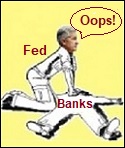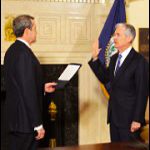-
Recent Posts
- Trump’s “Big Beautiful Bill” Is a Grotesque Giveaway to Fossil Fuel Billionaires While Adding $3.3 Trillion to Nation’s Debt
- Senator Chris Murphy Charges that Trump “Has Opened a Channel for Bribery”
- Congressman Casten: Trump’s Assault on the Rule of Law Is Causing Capital Flight Out of U.S. by Foreign Investors
- Trump’s Approval Rating Drops to 80-Year Low; IMF Says U.S. Tariffs Now Exceed the Highs During the Great Depression
- Nasdaq Has Lost More than 3,000 Points Since Trump’s First Full Day in Office in 2025; the Pain Has Barely Begun
- The Bond Crisis Last Week Was a Global No-Confidence Vote in U. S. President Donald Trump
- Trump’s Tariff Plan Guts $5 Trillion in Stock Value in Two Days; Senator Warren Calls for Emergency Action Before Markets Open on Monday
- Trump’s Attacks on Big Law, Universities, and the Media Have a Common Goal: Silence Dissent Against Authoritarian Rule
- Trump Administration Gives All Clear to Laundering Money through Shell Companies and Bribing Foreign Officials
- Four Megabanks on Wall Street Hold $3.2 Trillion in Uninsured Deposits – Which May Explain Senator Schumer’s Pivot to the GOP to Stop a Government Shutdown
- Here’s What Came Crashing Down Yesterday for Trump’s “Genius” Guy, Elon Musk: Tesla Stock, Access to Twitter (X), His Years of Secret Calls with Putin
- After Banning the Associated Press, Trump Is Now Targeting Specific Journalists That He Wants to See Fired
- Closely Watched Atlanta Fed Model Predicts Negative U.S. Growth in First Quarter
- Trump’s Gangster Diplomacy Makes Front Page Headlines Around the Globe
- Who Benefits Alongside Elon Musk If He Succeeds in Killing the CFPB: the Megabanks on Wall Street that Underwrite His Tesla Stock Offerings
- In Trump 1.0, the State Department Used Taxpayer Money to Publish a Book Elevating Elon Musk to a Superhero; It Was Funded by USAID, the Agency Musk Wants to Quickly Shut Down
- News Host Joy Reid Raises Threat of Trump Selling U.S. to Putin; Ten Days Later Her Show Is Cancelled
- Elon Musk’s DOGE Appears to Be Violating a Court Order; It Has Taken Down Hundreds of YouTube Videos that Educate Americans on How to Avoid Being Swindled
- Barron’s Releases Audio of Jamie Dimon Cursing Out His Workers at a Town Hall, as Dimon Plans to Dump Another One Million JPM Shares
- There’s One Federal Investigative Agency that Neither Trump nor Elon Musk Can Touch: It Just Opened an Investigation into DOGE
- Elon Musk’s Companies Were Under Investigation by Five Inspectors General When the Trump Administration Fired Them and Made Musk the Investigator
- Donald Trump Gives the Greenlight to Goldman Sachs and JPMorgan Chase to Return to Bribing Foreign Officials
- After Tech Geeks Built a Back Door to Loot Billions from FTX, Republicans Refuse to Investigate What Elon Musk’s Tech-Squad Did Inside the U.S. Treasury’s Payment System
- Former Prosecutor, Now U.S. Senator, Informs Tesla That CEO Musk May Be Violating Federal Law and to “Preserve All Records”
- Trump’s Hedge Fund Guy Is Now Overseeing the U.S. Treasury, IRS, OCC, U.S. Mint, FinCEN, F-SOC, and the Consumer Financial Protection Bureau
- As Elon Musk Begins Shutting Down Payments to Federal Contractors, a Strange Money Trail Emerges to His Operatives Inside the U.S. Treasury’s Payment System
- JPMorgan Chase Charged by Yet Another Internal Whistleblower with Cooking the Books
- We Asked Google’s AI Search Model, Gemini, Questions About the Fed and Wall Street Megabanks: It Got the Answers Dead Wrong
- With Trump and Melania’s Crypto Coins Likely to Raise Legal Challenges, Why Didn’t Trump Fire the SEC’s Inspector General in His Purge of IGs?
- Fossil Fuel Industry Could End Up Paying Tens of Billions for LA Wildfires and Deceiving the Public on Climate Change for Decades
- It’s Being Called the Biggest Grift by a President in U.S. History: Trump and First Lady Launch their Own Crypto Coins
- Trump Plans to Install a Fracking CEO to Head the Energy Department and Declare a National Emergency on Energy to Gain Vast Powers
- Fossil Fuel Money Played a Role in the Los Angeles Fires and the Push to Install Pete Hegseth as Secretary of Defense
- When It Comes to Wealth Retention in Retirement, Concrete May Be the New Gold
- Wall Street Watchdog Warns “Clock Is Ticking on a Coming Catastrophic Financial Crash”
- Wall Street Is Sending the Same Message to Americans on Fossil Fuel Financing that It Sent on Cigarettes: Drop Dead
- In a Six-Week Span, this Dark Pool with a Curious Past Traded 3.7 Billion Shares
- Wall Street’s Lobby Firm Hired Eugene Scalia of Gibson Dunn to Sue the Fed for Jamie Dimon
- Postmaster General Louis DeJoy Made $561,051 in Compensation in 2024, as Mail Costs Spiked and Delivery Deteriorated
- Fed Chair Jay Powell Sends a Bold Message to Trump and Tanks the Dow by 1123 Points
- The Head of Fixed Income at T. Rowe Price Makes the Scary Case for the 10-Year Treasury to Spike to 6 Percent
- $663 Billion in Cash Assets Have Gone Poof at the Largest U.S. Banks
- Donald Trump to Ring Bell at New York Stock Exchange Today as Hit List Posters Appear in Manhattan Targeting Wall Street CEOs
- Trump Has a Slush Fund to Prop Up the Dollar – Will He Use It to Prop Up Bitcoin Instead?
- A CEO Assassination; a Billionaire Heiress/NYPD Commissioner; a Secret Wall Street Spy Center – Here’s How They’re Connected
- Despite More than 1600 Tech Scientists Signing a Letter Calling Crypto a Sham, Trump Names a Crypto Cheerleader for SEC Chair
- The Fed Rings a Warning Bell: Hedge Funds and Life Insurers Are Reporting Historic Leverage
- Trump’s Nominee for FBI Director, Kash Patel, Has Businesses Financially Intertwined with Trump
- Donald Trump Is at Risk of Getting Named in a Fossil Fuels Conspiracy Lawsuit
- Trump Is Having Difficulty Getting a Lawyer to Accept the Nomination for SEC Chair: Here’s Why
Search Results for: Federal Reserve
Wall Street’s Most Dangerous Derivative Secrets Are Hiding in Plain Sight in a Regulator’s Report

By Pam Martens and Russ Martens: June 21, 2023 ~ On March 17, 2022, the Federal Reserve began its interest rate hiking cycle, which has, thus far, evolved into 10 consecutive rate hikes, making it the fastest rate increases in 40 years. The Fed’s actions to tame inflation included four consecutive interest rate hikes of an aggressive 75 basis point hike (three quarters of one percent) on June 16, July 28, September 22, and November 3 of last year. At that point, every trading veteran on Wall Street was scratching their head and asking themselves the same question: why aren’t we hearing about interest rate derivatives blowing up and taking down either a U.S. mega bank or its counterparty on the wrong side of the trade? According to the quarterly derivative reports released by the Office of the Comptroller of the Currency (OCC), the regulator of national banks, as of December … Continue reading
JPMorgan/Jeffrey Epstein Cases Are a Cross Between the Bank’s Chinese Princeling Scandal and Madoff Fraud, Using Sex with Minors as a Bribe

By Pam Martens and Russ Martens: June 20, 2023 ~ The tenure of Jamie Dimon as Chairman and CEO of JPMorgan Chase, the largest federally-insured bank in the United States and the largest trading casino on Wall Street, has copiously revealed the following: the bank is more than willing to look the other way at crime if it means an increase in assets, profits or business referrals. Each of those three ingredients were present in the bank’s decades long involvement with Bernie Madoff, with its Chinese Princeling scandal and in the unfolding details of its intimate relationship with child sex trafficker Jeffrey Epstein. This reality may be difficult for the New York business press to acknowledge – since it has mostly covered Jamie Dimon as the grand statesman of Wall Street – but this is the hard reality nonetheless. Yesterday, the Wall Street Journal’s Khadeeja Safdar and David Benoit revealed the … Continue reading
“Relationship Managers” Handled Collapsed Silvergate and Signature Banks’ Crypto Accounts; Citibank’s Dictator Accounts; and JPMorgan’s Jeffrey Epstein Accounts

By Pam Martens and Russ Martens: June 12, 2023 ~ A dangerous malignancy has been growing on the U.S. banking system for at least two dozen years: It’s the job function benignly called the “Relationship Manager.” In October 2013, Carmen Segarra, a lawyer and former Bank Examiner at the Federal Reserve Bank of New York, filed a federal lawsuit alleging that Relationship Managers there, who were assigned to delicately manage relationships between the New York Fed and the powerful Wall Street banks, had obstructed and interfered with her investigation of Goldman Sachs and tried to bully her into changing her negative findings. When Segarra refused to change her examination, she was fired, according to a federal lawsuit she filed. In 2018, Segarra provided a more detailed accounting of how these corrupted relationships play out in her book, Noncompliant: A Lone Whistleblower Exposes the Giants of Wall Street. Given the influence that … Continue reading
Silvergate Bank Lands in the Middle of Another Massive Alleged Crypto Fraud – This Time at Binance

By Pam Martens and Russ Martens: June 7, 2023 ~ It’s only June 7, but the liquidating, federally-insured, crypto-loving Silvergate Bank is having one helluva month. On June 1, the Federal Reserve released an enforcement action (called a Cease and Desist Consent Order) that it and a California banking regulator had filed against Silvergate Bank and its parent, Silvergate Capital Corporation. (See our report: Disgraced Silvergate Bank Hints It May Not Be Able to Cover All of Its Deposits; Fed Slaps It with a Cease and Desist Consent Order.) The bank had announced on March 8 that it was going to voluntarily wind down and liquidate itself. The announcement followed a run on the bank when news articles began appearing linking Silvergate Bank to indicted crypto kingpin, Sam Bankman-Fried. The bank is facing a growing roster of lawsuits on charges that it moved customer funds deposited at Bankman-Fried’s crypto exchange, FTX, to … Continue reading
JPMorgan and Citigroup Are Using the Same Accounting Maneuver as Silicon Valley Bank on Hundreds of Billions of Underwater Debt Securities

By Pam Martens and Russ Martens: June 6, 2023 ~ As we reported yesterday, Silicon Valley Bank was not even on the “Problem Bank List” maintained by the Federal Deposit Insurance Corporation (FDIC) when it imploded in a span of 48 hours in March. According to testimony by the Federal Reserve’s Vice Chairman for Supervision, Michael Barr, on March 28 before the Senate Banking Committee, depositors had yanked $42 billion of their deposits from the bank on March 9 and had queued up to grab another $100 billion on March 10 when it was abruptly put into FDIC receivership. Had the FDIC not stepped in, Silicon Valley Bank would have lost 85 percent of its deposits in a two-day stretch. Two of the key internal problems at Silicon Valley Bank were its large amount of uninsured deposits (which pose a flight risk in times of banking turmoil) and Silicon Valley Bank’s … Continue reading
Disgraced Silvergate Bank Hints It May Not Be Able to Cover All of Its Deposits; Fed Slaps It with a Cease and Desist Consent Order

By Pam Martens and Russ Martens: June 2, 2023 ~ Last week, on Tuesday, May 23, the Federal Reserve and California Department of Financial Protection and Innovation (the state banking regulator) hit the collapsed federally-insured bank, Silvergate Bank, and its parent, Silvergate Capital Corporation, with an enforcement action called a “Cease and Desist Consent Order.” The action was not announced to the public until yesterday. A Consent Order is meant to function along the lines of a legal settlement, with the bank agreeing to the detailed terms of the Consent Order and waiving its right to judicial review. The individual signing the Consent Order on behalf of the bank was its controversial CEO, Alan Lane, who had allowed his federally-insured bank to get in bed with Sam Bankman-Fried’s house of frauds, including the FTX crypto exchange and Bankman-Fried’s hedge fund, Alameda Research. Lane also had allowed his deposit base to become … Continue reading
IMF Says Fed Will Have to Remain Tight at 5 ¼ to 5 ½ Rate Until Late 2024; Warns of “Unpredictable Consequences” to Banks

By Pam Martens and Russ Martens: May 31, 2023 ~ Last Friday, at the start of Memorial Day weekend, researchers at the International Monetary Fund (IMF) released an analysis of where they think the U.S. economy is headed and the headwinds (read gale force winds) that can, potentially, be expected along the way. Folks on Wall Street who were hoping that the Fed was at the end of its rate-hiking cycle, with a more dovish Fed juicing stock market returns later this year, likely had their holiday weekend ruined with this projection from the IMF: “Achieving a sustained disinflation will necessitate a loosening of labor market conditions that, so far, has not been evident in the data. To bring inflation firmly back to target will require an extended period of tight monetary policy, with the federal funds rate remaining at 5¼–5½ percent until late in 2024.” The Fed’s inflation target is … Continue reading
New Evidence Emerges that the Investigation of the Fed’s Trading Scandal by the Inspector General Has Been a Coverup from the Beginning

By Pam Martens and Russ Martens: May 25, 2023 ~ Unlike his three immediate predecessors who chaired the Federal Reserve (Janet Yellen, Ben Bernanke and Alan Greenspan), who all had doctoral degrees in economics, the current Fed Chairman, Jerome Powell, has a law degree from Georgetown University. Given his legal education, one might have expected that when Fed Chair Powell became aware of the largest trading scandal in the Fed’s history in September of 2021, he would have done his legal due diligence to determine where to refer the matter for investigation. While multiple Wall Street watchdogs called for Powell to refer the investigation to the U.S. Department of Justice and the Securities and Exchange Commission – which conduct all legitimate insider trading investigations involving publicly-traded stocks — the Fed instead referred the investigation on October 4, 2021 to the Federal Reserve Board’s own Inspector General, who is appointed by the … Continue reading
JPMorgan Chase and Jeffrey Epstein Were Both Involved in a Strange Offshore Company Called Liquid Funding

By Pam Martens and Russ Martens: May 24, 2023 ~ This Friday and Saturday, JPMorgan Chase’s Chairman and CEO, Jamie Dimon, is scheduled to sit for some very uncomfortable questioning in a deposition concerning what role he played in allowing his bank to serve as a vast cash conduit for Jeffrey Epstein, which enabled Epstein to perpetuate his sex trafficking of underage girls. The Attorney General’s office of the U.S. Virgin Islands (USVI) has filed a federal lawsuit against JPMorgan Chase that makes devastating charges against the largest bank in the United States. It alleges that JPMorgan Chase sat on a mountain of evidence that Jeffrey Epstein was running a child sex trafficking ring as it continued to keep him as a client; accept his lucrative referrals of wealthy clients; and provided him with large sums of cash and wire transfers to pay off victims – one of whom was a “14-year old … Continue reading
The Fed Has a New Scandal on Its Hands: Colluding with Central Banks to Rig Libor; Evidence Is Being Tweeted Out

By Pam Martens and Russ Martens: May 23, 2023 ~ The Fed has been under non-stop scandals for the past two years. It pumped out trillions of dollars in repo loans to Wall Street’s casino banks beginning on September 17, 2019 and then made up a hokey excuse to cover up its massive bailout of banks it is incompetent to supervise. After former Dallas Fed President, Robert Kaplan, was caught trading like a hedge fund kingpin while sitting on confidential Fed information, the Fed’s Board of Governors had the audacity to refer the matter to its own Inspector General, who reports to the Fed’s Board of Governors and can be fired by it. Not surprisingly, 19 months later there’s still no word on this investigation. Then there was the President of the St. Louis Fed, James Bullard, who was caught giving a private meeting with Citigroup clients. The New York Fed … Continue reading

